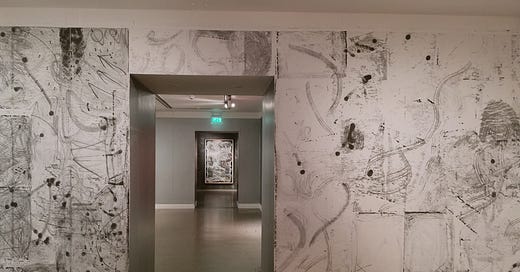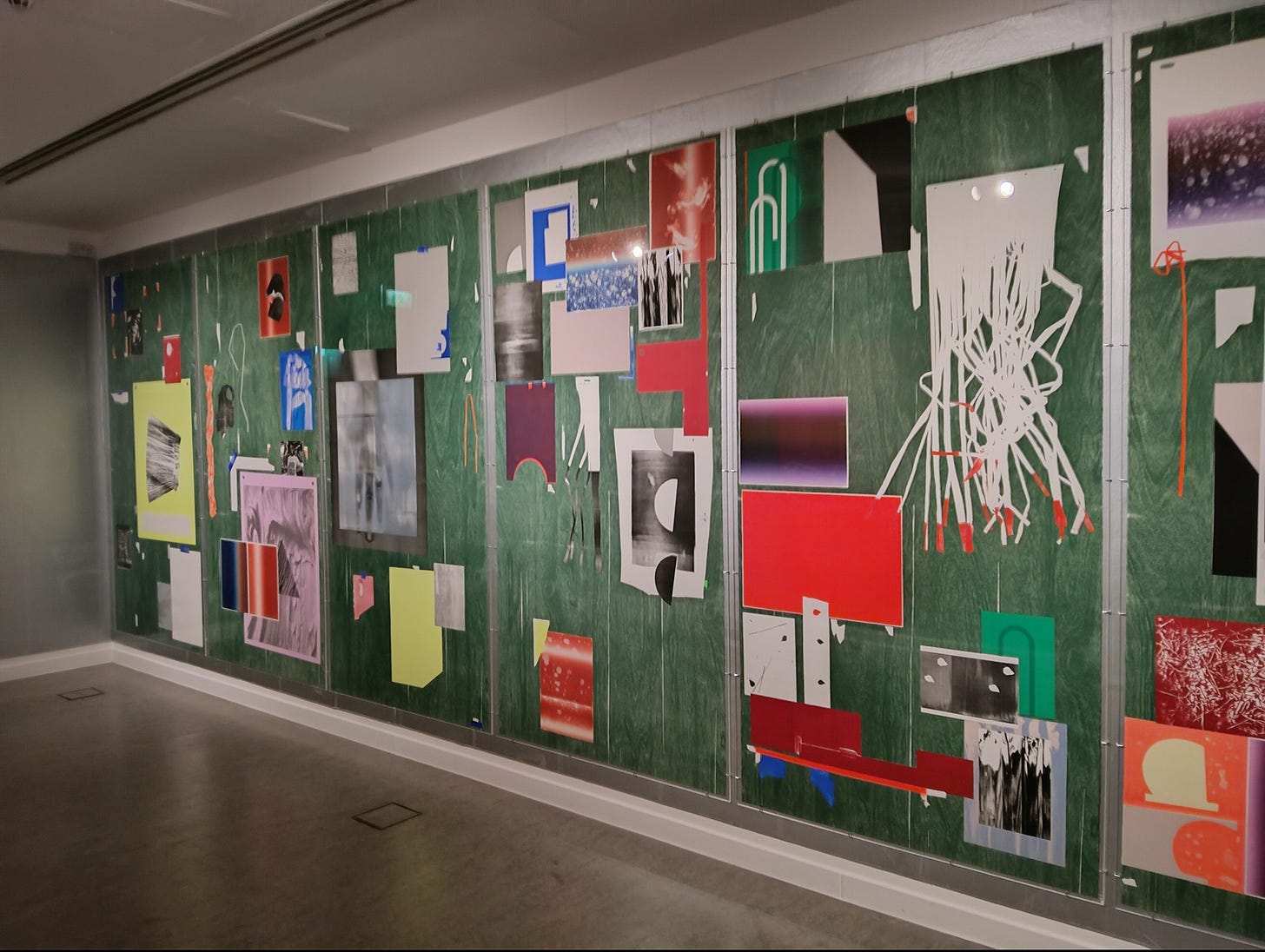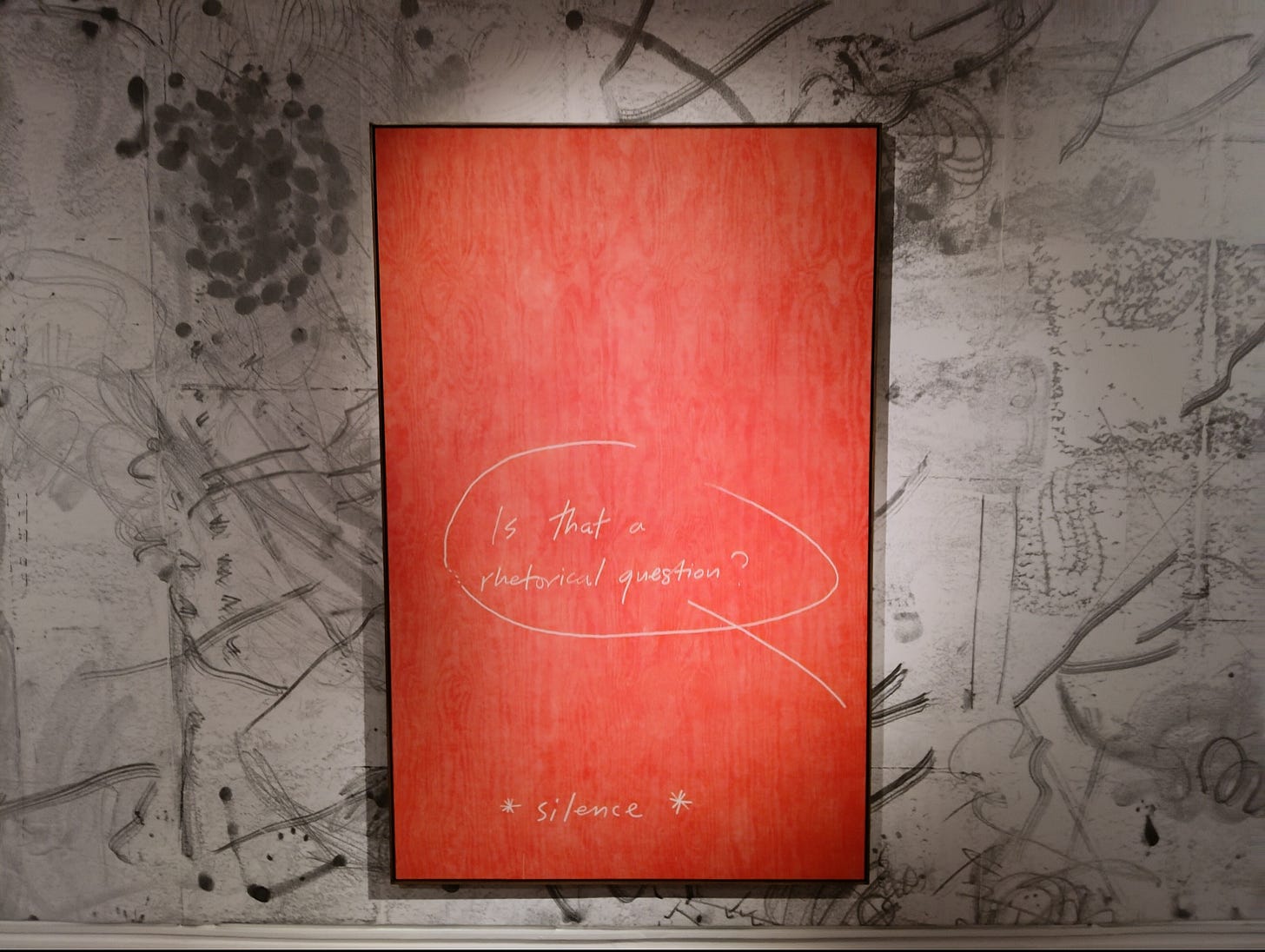In 2002, Canadian-Irish artist Ciara Phillips pitched up at Glasgow School of Art to study for a Masters. She ended up staying in the city for nearly two decades, much of the time spent living and working in Dennistoun. Glasgow has that effect on people, especially artists. She was nominated for the Turner Prize in 2014 and is currently resident in Norway, where she teaches at the University of Bergen’s Institute of Contemporary Art. Now she has returned to Scotland for a welcome solo show at Glasgow’s Gallery of Modern Art (GoMA), an exhibition long in the planning but beset by delays and frustrations.
At GoMA, Phillips presents three rooms of new work in a space given a site-specific makeover thanks to the use of hand-designed wallpapers to decorate it. Made using the monoprint process, they combine delicate marks – ribboned sequences, arrows, other less discernible shapes – with gestural sweeps achieved by the artist lying or standing on the paper. The thick dark smudges are heel marks, she tells me, during our walk round. Combined with the silvery-grey wallpaper in the first room, it contrasts with the often vibrant colours of the 11 works collected here and makes for an immersive overall experience. It is also a work in its own right and the newest one, as reflected in its title: ANNO 2025.
Phillips is essentially a printmaker, though in the jargon of the art world her ‘practice’ involves ‘interrogating’ both the process of making prints and the medium itself. The exhibition title, Undoing It, nods to that, though among its other potential readings is a broader political one pointing to environmental collapse, social division, the fracturing of old certainties. Pick one or all or none of those.
The politics is not explicit and Phillips doesn’t want it to be. But peer closely at the huge, six panel work which dominates the second room (the title is a very lengthy and typically obtuse quotation from Gertrude Stein which I won’t relay here) and you’ll see among the assembled relief prints a photo of a young woman in sunglasses wearing a t-shirt whose slogan reads: ‘Apathy Kills.’ Meanwhile, on the three panel woodcut and screen-print work dominating the third room, I Tell My Students, is a postcard reading: ‘Empathy is a political issue.’
Elsewhere on the same work is a quotation from author Toni Morrison which hangs on the wall of Phillips’ own studio. This relates Morrison’s advice to her own students – an exhortation to do what they do “loudly and consistently” and “to keep asserting the complexity and the originality of life”. But it chimes with Phillips’ long-noted interest in the teachings of inspirational nun turned printmaker, educator and Pop Art pioneer, Sister Corita Kent. I don’t know if Phillips still digs Kent, or the extent to which Kent’s work inspires hers, but in the large, collage-based works here – relief prints both abstract and graphic assembled to form other, bigger prints – it’s worth remembering Kent’s famous maxims for art, especially Rules Four and Six: ‘Consider everything an experiment’ and ‘There’s no win and no fail. There’s only make.’
Alongside the two multi-panel works are others. Two large studies in pure form made using the fluid soap ground etching technique, one in a pleasing shade of purple-pink. The mightily enigmatic Ghost, hanging by the entrance. Four text-based woodcuts printed onto large canvases. On these the grain of the wood is subtle and the texts are mostly taken from Phillips’ sketchbooks. One, Gradient, is a design for some kind of cylindrical object complete with notes on colours. Another, *silence*, features a speech bubble and the words: ‘Is that a rhetorical question?’. The one titled ANNO 2020 resembles a school blackboard and features a morbid exchange between two speakers. It’s an extrapolation from The Death Dance Of Basel, a 15th century Swiss mural-cum-allegory comparable with the mediaeval Danse Macabre, or Dance of Death.
Finally, at least in terms of scale, are two smaller and more intimate works. Phillips can be glimpsed in some of the relief prints which make up the bigger works – grinning, she shows me how if you view one silvered panel at the right angle her face appears – and in Antidote, a lithograph, we see a close up of the back of her head, with her hair plaited into a thick tress. The only other element is what looks like a sliver of moon – the same heavenly body which seems to be shown in Lingerer, another small lithograph.
Phillips confides that she misses Glasgow and is delighted to be back, albeit briefly. Glasgow, equally, should be happy at the return – and at the presentation of a new body of work which is staying for much longer and which is as open and inspiring as it is chewy and beguiling.
Undoing It is at the Gallery of Modern Art, Glasgow (until October 26)







